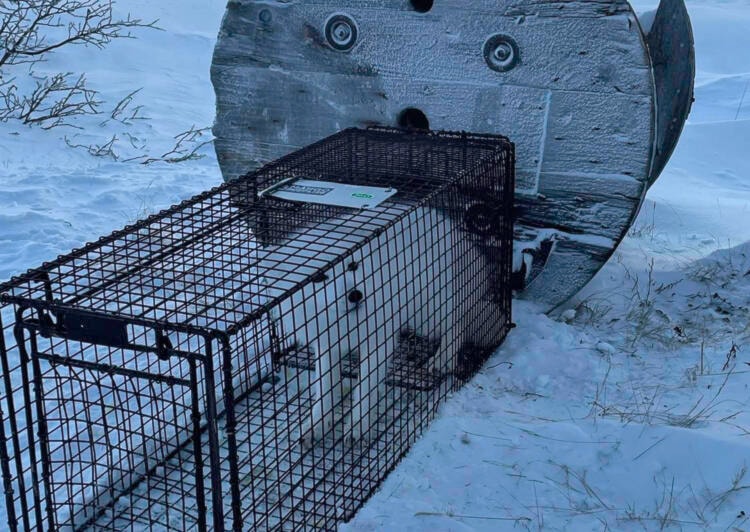Johanne Coutu-Autut has trapped 55 foxes and climbing around Rankin Inlet since December, a number only matched in other boom years for the population.
“The lemmings were very abundant last year,” said the conservation officer, noting that fox populations rise and fall with prey populations – lemmings being their prime source of food.
Rabies is endemic in the North, meaning it is always present among the fox population, even in lower-population years.
With more foxes around this winter, there is more spread of the disease as the chances of foxes biting each other increases, and along with that, there is more risk for rabies contacts with people and dogs.
“Once an animal gets rabies, it will die,” said Coutu-Autut, adding that all mammals can carry the virus, including wolves and polar bears.
“Foxes are the main reservoir for rabies in Nunavut. That’s why it’s very important to control the foxes coming into the community, because you never know which one is carrying the virus.”
She suspects some of the foxes she’s live-trapped had rabies, but they don’t get sent out for testing unless there’s an encounter with a pet or human.
Gary Nelson, environmental health officer, said there’s little value in sending animals out for testing unless they bite a person or dog and the owner wants to keep the dog alive.
“The assumption is if you have a fox within a community, that’s not really fox-like behaviour,” he said. “Foxes typically wouldn’t attack a dog or human, so if that happens, usually the animal is assumed to have rabies.”
Rabies can display in two main ways: furious rabies and dumb rabies.
The former is the well-known type, where animals become unusually aggressive. When they get to frothing at the mouth, that’s because their throat has been paralyzed and they can no longer swallow, which is a sign of a late stage of the disease. The well-known staggering and lack of balance presents because of how the virus damages the nerves in the animal’s rear end.
But because the rabies virus affects the brain, sometimes it manifests in other ways, such as making the animal more tame or friendly.
Nelson remembers a potential case of this a few years ago in Rankin Inlet, when children were playing with a docile fox in town.
Because rabies is present in saliva, even playing with a fox can present danger if one were to touch their face afterward.
Anyone scratched or bitten by a fox or dog should immediately contact the health centre for a rabies assessment, even if the owner is confident their dog is vaccinated.
“You wouldn’t want to risk your life on you thinking your dog doesn’t have rabies,” said Nelson, even if a small scratch from a domestic dog seems innocent enough. “I wouldn’t suggest that. I would suggest going to the health centre and having a nurse assess you.”
Though rabies deaths are very rare, the disease is fatal in humans if untreated. Proper treatment after exposure is very effective, but signs of symptoms would already be too late .
That’s what happened for the last rabies death in Canada in 2019. A bat flew into the hand of a B.C. man who didn’t realize he had been exposed. He began showing symptoms six weeks later and soon died.
Earlier this year, Nelson followed a case of an Iglulik woman who was bitten by a fox.
“My key message to the public is if you are bitten or scratched by a fox, dog or wolf, contact the health centre and let the nurses know, so we can assess if you need to be treated right away,” he said.
“Rabies is a fatal disease in humans. If you are exposed potentially to getting rabies and you don’t receive treatment right away, unfortunately, when you show signs or symptoms of having the disease, you’re probably going to die.”
Thankfully, the woman in Iglulik received the proper treatment. Nelson said he is actively following up on about four to 15 people receiving treatment for rabies at any given time. The treatment involves an immediate injection, plus four doses of vaccine spread over a time interval.
“Rabies is a risk in Nunavut all of the time, and people need to be mindful of that,” he said.
Those in high-risk professions, like bylaw and police, can usually get the rabies vaccine before exposure. Hunters and trappers who have close contact with foxes should contact the health centre and be assessed if a pre-exposure vaccine would be appropriate.
All dogs and cats can be vaccinated for free by Rankin Inlet’s bylaw department. If owners are unsure of their pet’s vaccination history, it’s best to vaccinate them annually, said Coutu-Autut. Otherwise, vaccinations every three years is the normal schedule for dogs with proper documentation. Puppies cannot receive the vaccine in the first four months of their life, which is reason for extra caution around them.
Because of the high fox population this year, authorities are urging residents to be on the lookout for foxes and keep control of their dogs.
“Don’t tell me ‘I saw a fox yesterday,’” said Coutu-Autut, suggesting people contact her immediately when they see one in Rankin Inlet. “The fox can be long gone by that time.”
Even if the fox isn’t acting strangely, it could be rabid. That’s why Coutu-Autut doesn’t tolerate any foxes in town.
Rankin Inlet’s conservation officer can be reached at 867-645-6447. If that fails, residents can contact the RCMP or bylaw as well.
